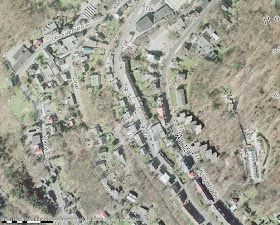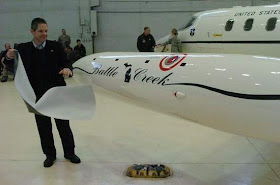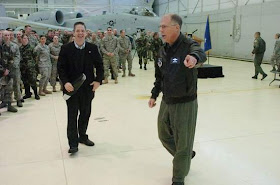by Capt. Laura Ropelis
Air Force Special Operations Command Public Affairs
12/24/2008 - HURLBURT FIELD, Fla. (AFNS) -- An Air Force Special Operations Command Airman saved lives in Afghanistan April 6 during a lengthy battle by calling in airstrikes to protect his team.
Staff Sgt. Zachary Rhyner, a special tactics combat controller assigned to the 21st Special Tactics Squadron at Pope Air Force Base, N.C., was deployed to Operation Enduring Freedom as the primary joint terminal attack controller while attached to special forces team Operational Detachment Alpha 3336, 3rd Special Forces Group.
Then a senior airman, Sergeant Rhyner was part of a 130-man combined assault force whose mission was to enter Shok Valley and capture a high-value target who was funding the insurgency. Sergeant Rhyner is credited with saving his10-man team from being overrun twice in a 6.5-hour battle.
Capt. Stewart Parker, the detachment commander at Bagram Airfield, Afghanistan, was the command and control link to the JTACs on the ground as they went into Shok Valley.
"This was the first time U.S. special operations forces entered the territory," Captain Parker said. "These were extraordinary conditions and the situation was dynamic."
Shok Valley is located below 60-foot cliffs. The mission objective was at the top of the mountains surrounding the valley.
"Initial infiltration began that day with snow on the ground, jagged rocks, a fast-moving river and a cliff," Sergeant Rhyner said. "There was a 5-foot wall you had to pull yourself up. The ridgeline trail was out of control."
The expectation was to encounter fire from about 70 insurgents. One Air Force JTAC-qualified combat controller was attached to each team to call in airstrikes, if needed.
"We were caught off guard as 200 enemy fighters approached," said Staff Sgt. Rob Gutierrez, a combat controller with the second team in the fight. "Within 10 minutes, we were ambushed with heavy fire from 50 meters. The teams were split by a river 100 to 200 meters apart, north to south."
Sergeant Rhyner was in charge of coordinating the air assets.
"I have never seen a situation this bad," said Captain Parker, who was monitoring the situation back at the base. "The intel said the enemy was 40 feet away from Zach and his team at one point. It was dangerous."
Within the first 15 minutes of fire, Sergeant Rhyner was wounded along with three team members.
"I was pulling security when I got shot in the leg," he said. "The rounds hit my left thigh and went through my leg and hit another guy in the foot."
Sergeant Rhyner said he immediately felt pain and adrenalin.
"There was nowhere to go. I grabbed the wounded guys, but we were trapped by the enemy," he said. "I was calling in airstrikes and firing, while moving the wounded down (the cliff)."
Sergeant Gutierrez said he could see insurgent fire coming from the buildings on the hilltops above them and was trying to get across the river to meet up with Sergeant Rhyner.
"Zach and I were in constant radio contact," he said. "I could hear the ammunition, sniper fire and rocket-propelled grenades with multiple blasts. We tried to push to the north to collocate with Zach's team, but every time we pushed up river, it put us in an open line of fire."
"My team ran across the freezing river. The water came off the mountains, and we were 100 to 200 feet beneath the enemy, like fish in a barrel," Sergeant Gutierrez said.
As the enemy surrounded them, Sergeant Rhyner, who was being treated for his injuries by Capt. Kyle Walton, the special forces team leader, directed multiple rockets and gun runs from AH-64 Apache helicopters against enemy positions.
"Zach was coordinating tremendous amounts of fire on both villages simultaneously," Sergeant Gutierrez said. "Zach was in charge of the airstrikes, since he was closest to the fight and could see even what the F-15 (Eagle) pilots could not."
Forty-five minutes to an hour had gone by since the fight began.
"We were pinned down and I could see the enemy all over the hills running around," Sergeant Gutierrez said. There were no stable targets. I kept the Apaches and the Hellfire missiles pressed to the north."
Accurate sniper, machine gun and RPG fire poured down on the assault force in a complex ambush initiated simultaneously from all directions as Alpha Team 3336 ascended the near-vertical terrain. He called in more than 50 close airstrikes and strafing runs.
Three hours into the fight, Sergeant Gutierrez reached Sergeant Rhyner's position.
"Sergeant Gutierrez and I met on the cliff during the battle briefly. We shared a laugh, but it was a busy, bleak situation," Sergeant Rhyner said.
Sergeant Rhyner had been calling in airstrikes for three hours while he was injured; however, he still felt responsible for the others who had been hurt. With disregard for his own life, he tried to get the injured to safety, still in the open line of fire.
"I left injured personnel in a house and I had to get over there," he said. "I was frustrated being wounded. I tried to get the bombs there fast and talk to the pilots who didn't see what I saw on the ground."
Five or six hours into the fight, as it was getting dark, intelligence informed the JTACs that enemy reinforcements were 10 kilometers away carrying enemy rockets and missiles.
"We continued to fight our way up the hill and the (helicopters) came," Sergeant Gutierrez said. "Zach was talking to the helos and gave the coordinates to lay the bombs on the village, while I kept the A-10 (Thunderbolt IIs) and the Apaches out of the way."
Sergeant Rhyner called in a total of 4,570 rounds of cannon fire, nine Hellfire missiles, 162 rockets, 12 500-pound bombs and one 2,000-pound bomb, constantly engaging the enemy with his M-4 rifle to deter their advance.
"Zach acted fast and shut down the fighting," Sergeant Gutierrez said. "The wounded were taken out on medevac."
Back at command and control, Captain Parker heard that the helicopters were on the ground with the wounded but he could not move the helicopters due to the terrain and weather conditions.
"Radio transmissions would block the signal due to terrain and vertical cliffs," he said. "Helicopters were vulnerable and there was pressure to do everything we could to get the teams out quickly."
Fog then started rolling into the valley.
"At 8,000 feet, the helicopter couldn't fly (due to altitude) and the situation called for 'aggressive patience,'" Captain Parker said. "More than 50 percent of the U.S. forces were wounded, and it was pretty grave."
Toward the end of the fighting, 40 insurgents were killed and 100 wounded.
Sergeant Rhyner was directly credited with the entire team's survival due to his skill and poise under intense fire.
"Sergeant Rhyner is out of training less than a year and is in one of the most difficult situations," Captain Parker said. "It is an absolute testament to his character and the training these guys take. It tells me we are doing something right."
"If it wasn't for Zach, I wouldn't be here," Sergeant Gutierrez said.
Sergeant Rhyner received the Jewish Institute for National Security Affairs Grateful Nation Award Dec. 8 in Washington, D.C., and is awaiting the presentation of a Purple Heart for the injuries he suffered during the battle.
SourceNote: It looks to me that the involved A-10s were from the 81st FS, 52nd FW (USAFE), Spangdahlem AB, Germany, during their OEF deployment to Bagram AB, Afghanistan, as part of the AEF 1/2 (Cycle 7) rotation (January - April 2008).
Associated picture:

Staff Sgt. Zachary Rhyner receives the Jewish Institute for National Security Affairs Grateful Nation Award from Navy Adm. Michael C. Mullen during the Grateful Nation Award Ceremony on December 8, 2008, in Washington, D.C. Sergeant Rhyner is a special tactics combat controller assigned to the 21st Special Tactics Squadron at Pope AFB, North Carolina, and Admiral Mullen is the chairman of the Joint Chiefs of Staff. (Courtesy photo via USAF)








